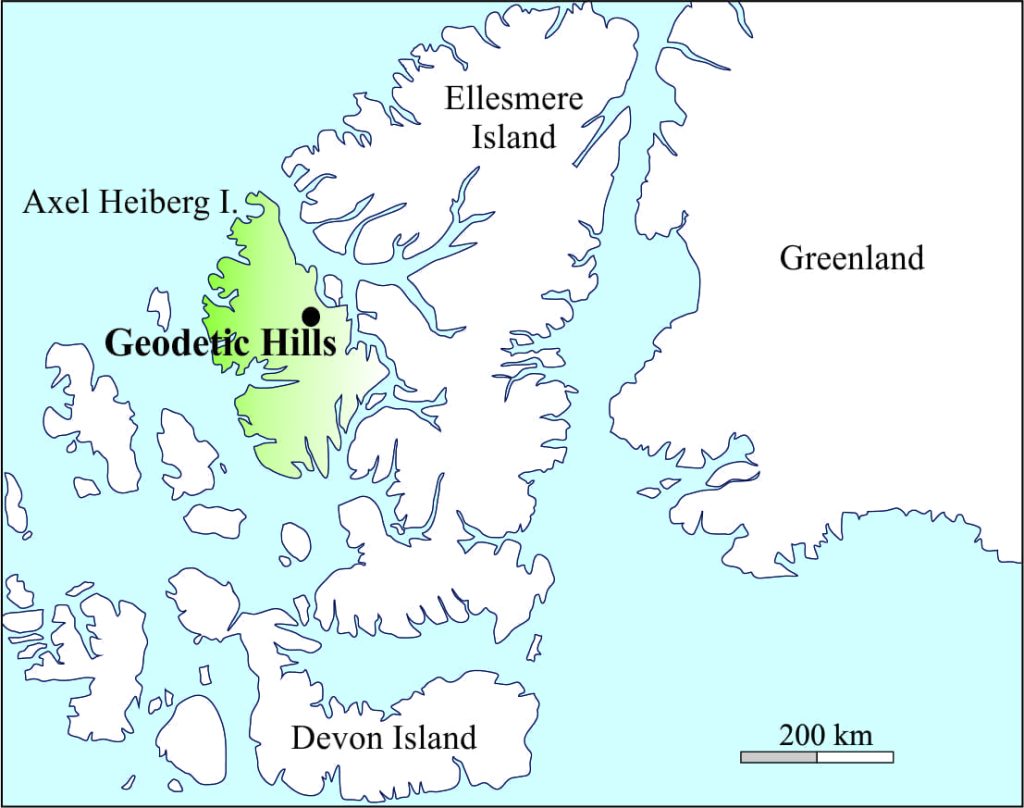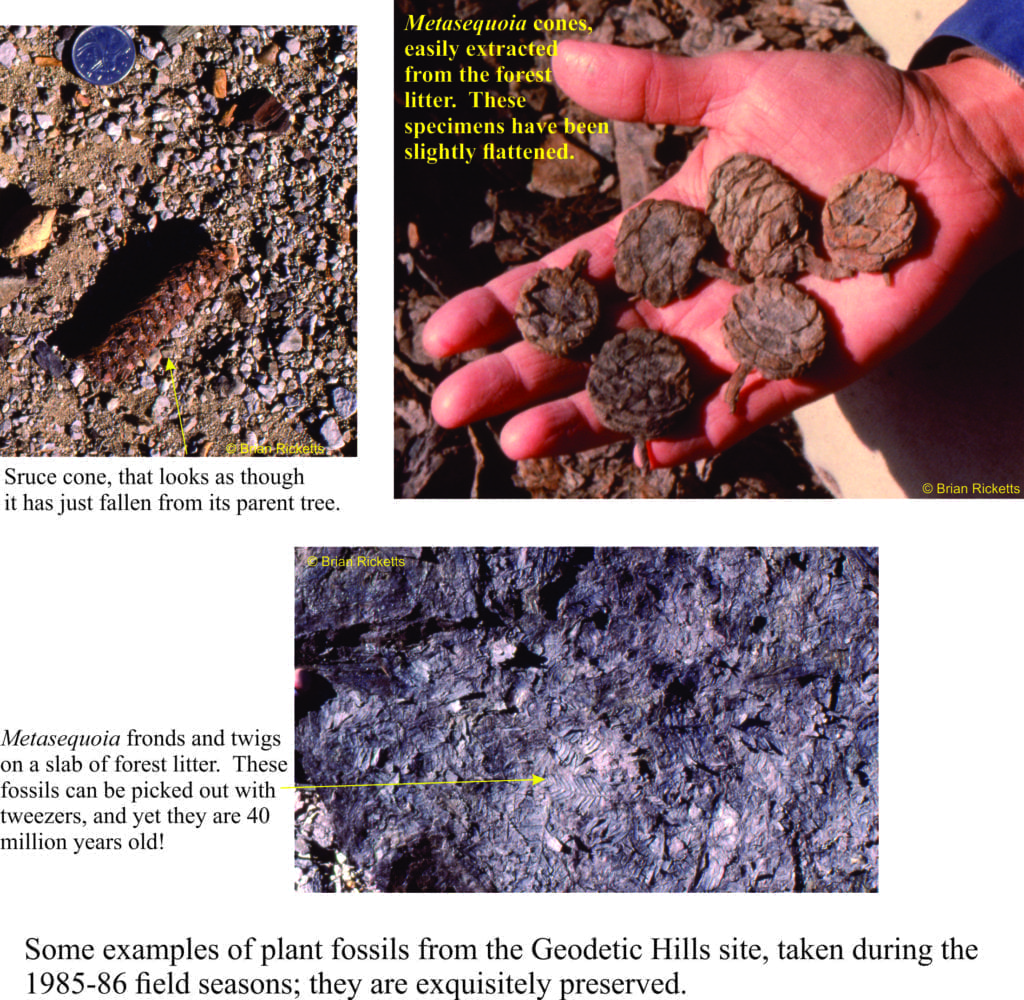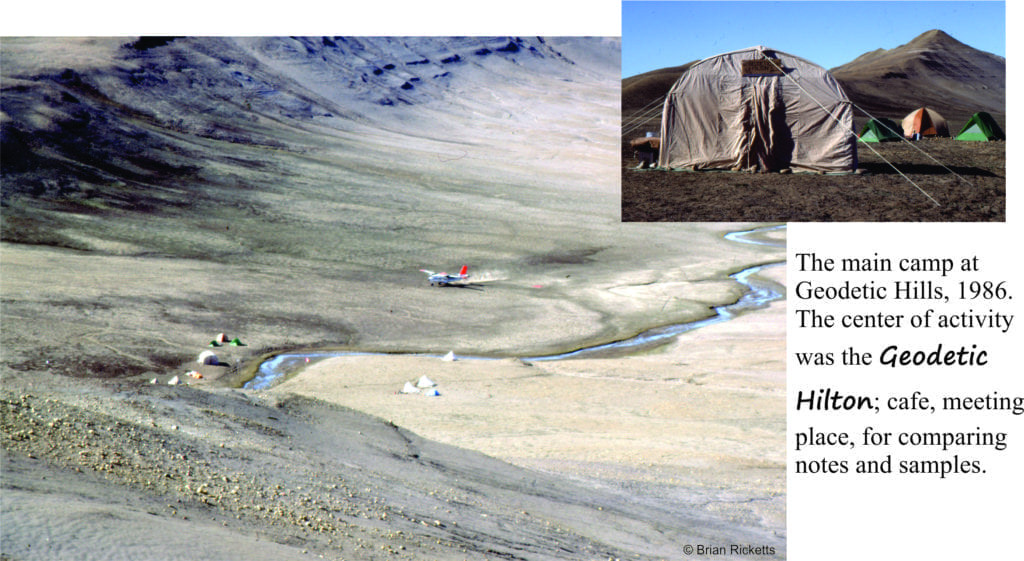The Stunning Preservation of an Arctic Fossil Forest


Continuing up the ridge, we chanced upon flat ground that, as luck would have it, allowed us to walk across the top of a coaly layer. It was stunning. Poking out of the layer were numerous tree trunks; we were basically walking through the remains of a very old forest, around the trees, stumbling on exposed roots, branches strewn across the ground. But the real surprise was that these trees were not coal; they were darkened by age, but there was still wood – mummified wood. And this stuff is 45 million years old!
On closer inspection the layers, in addition to tree stumps and logs galore, contained fossil leaves, cones and seeds that could easily be pulled intact from the deposit. It was like extracting plant remains from a recent forest litter. Some ancient spruce or fir cones looked almost as fresh as the day, 45 million years ago, they fell to the forest floor. Leaves and cones that even a non-paleobotanist like me could identify included oak, birch, hickory, Dawn Redwood (Metasequoia) and other conifers. The litter layers were a treasure-trove – here was good evidence for a climate back in the Eocene, that was much warmer than the more frigid conditions we were experiencing on that exposed Arctic hillside.
The puzzle continued…
There is another twist to the story. We know from plate tectonic theory that over long periods of geological time, continental and oceanic plates move in relation to each other, in some case many thousands of kilometers. Within this knowledge framework we also know that the land area now occupied by the Arctic Islands has basically been in the same position relative to the geographic North Pole for at least the last 100 million years. In other words, the forest was at a similar (high) latitude back in the Eocene as its fossil remains are now. This being the case, the ancient forests and whatever critters that lived therein must have experienced months of continuous summer daylight, and for the opposite season months of darkness. What kind of forests were they; and who lived there?
Back in the Eocene…
What was the rest of the world like 45 million years ago? Continental and oceanic plates (other than the Arctic landmass) were in quite different positions to where they are now. A consequence of this was that the distribution of land masses, mountain belts and ocean currents, all of which contribute or help drive climate change over millions of years, were also different. Significantly, the Geodetic Hills forests flourished at a time of mountain building on Ellesmere and Axel Heiberg islands.
There were no Antarctic or Greenland icecaps. The North Atlantic ocean was quite a bit narrower than it is today. Australia was separating from Antarctica about this time, opening a major seaway that changed ocean currents in that part of the world; New Zealand had already separated from the Antarctic-Australia amalgam (remnants of the Gondwana super continent) long before this time. And importantly, from the point of view of our Arctic forests, the global climate had veered into carbon dioxide-driven hothouse conditions. This then is the general backdrop to the forests we had discovered.
Fast-forward to 1986
The 1986 field season was the beginning of a concerted effort for different scientific groups to study the Geodetic Hills forests and other fossil sites in the region; this effort continues today. Geologists, paleobotanists, people who study fossil pollen (palynologists), wood, ancient soils, and the animal life, have at one time or another, converged on this site.
The first paleobotanical analyses by Jim Bassinger (University of Saskatchewan), Jane Francis (British Antarctic Survey) and their colleagues focused on the flora and forest dynamics (tree size, tree rings, spacing, canopy). More recent field excursions that extended beyond Geodetic Hills have concentrated on plant physiology, precipitation and seasonality by looking at leaf sizes, densities, floral associations and wood chemistry.
The list of plants includes ancient conifers, like hemlock, spruce, pine, larch and Dawn Redwood (Metasequoia, once thought to be extinct but subsequently found in China), the broadleaf-conifer relative Ginkgo, plus deciduous broadleaf trees like birch, alder, oak and sycamore, and ferns.
The only animal fossils to have been found at Geodetic Hills are the teeth of an ungulate (hooved mammal) that resembles a hippopotamus . However, slightly older Eocene deposits on nearby Ellesmere Island have revealed a diverse group of mammals such as small hedgehog-like animals, various rodents, tapirs, semi-aquatic creatures, badger-, fox-, and weasel-like carnivores, plus boa-like snakes and a species of alligator.
So what was the countryside like back in the Middle Eocene?
Picture a lowland area, carpeted with mixed conifer and deciduous broadleaf trees and shrubs, interspersed with swamps and bogs. Sluggish rivers meandered through, en-route to a more distant sea. Farther inland new mountains were shedding gravel, sand and mud some of which was moved by the rivers and deposited on their floodplains.
There are two main schools of thought on what climate prevailed here. Early studies, based on wood chemistry posited the hypothesis that the climate was wet and monsoonal, much like modern coastal Asia. However, a recent publication on slightly older Eocene deposits from the same area, written by Christopher West, David Greenwood and Jim Bassinger (in Earth & Planetary Science Letters, 2015) argues the case for a seasonal rainforest based on analysis of leaf areas and leaf margins, comparing these with modern British Columbia coastal conditions. These wet and warm conditions prevailed during earlier Eocene times; mean annual temperatures are estimated to have been 13o-15oC. The Geodetic Hills forests are a bit younger; it seems that the climate may have cooled slightly and perhaps was not quite as wet. But the forests flourished nonetheless. They were certainly a far cry from the more frigid climate that prevails there now.



